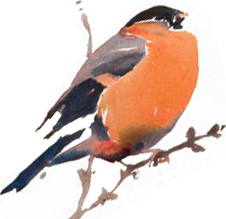There is a basic division in Scottish Birds between papers and short notes that are peer-reviewed and articles, news and Club items that are not. This split in content is differentiated by fonts used and paper colour.
The first part accepts manuscripts on the status, distribution and populations of birds in Scotland and, particularly, changes in these over time. Write-ups of census work find a natural home in this section, as do the culmination of research topics and updates to information in The Birds of Scotland (Forrester et al 2007). Original work and observations are encouraged, but summary papers will be considered and key-note papers of a more general nature may occasionally be commissioned. Papers should be fully referenced as in any scientific work, and our house style should be followed. Articles of less than 700 words are generally considered as Short Notes, but are otherwise in the same format.
Authors should bear in mind that only a small proportion of the Scottish Birds readership are scientists and should aim to present their material concisely, interestingly and clearly. Unfamiliar technical terms and symbols should be avoided wherever possible and, if deemed essential, should be explained. Supporting statistics should be kept to a minimum. All papers and short notes are accepted on the understanding that they have not been offered for publication elsewhere and that they will be subject to editing. Papers will be acknowledged on receipt and are normally reviewed by at least two members of the editorial panel and, in most cases also by an independent referee. They will normally be published in order of acceptance of fully revised manuscripts.
Scottish Birds publishes obituaries of Club members and others who have contributed to Scottish ornithology. These are organised through Waterston House, where the Office Manager will liaise with contributors. Book reviews are organised through the Club Librarian.
The second part of Scottish Birds welcomes informal as well as more serious contributions about any aspect of birds and their habitats in Scotland. It is not peer-reviewed, has minimal editing and contributions can be descriptive, anecdotal, controversial, humorous or quirky. They can report on surveys, express opinions, describe birds and places, look back into history, speculate as to the future and can represent organisations or be the work of private individuals. The documentation of rare and scarce birds in Scotland, plus a wide range of identification, site and species related information is lavishly illustrated by high quality colour photographs. We welcome photographs, maps, cartoons, and will accept basic graphs and tables when relevant. Meeting reports or field trip accounts are all welcome, but our main aim is to focus on Scottish birds in Scotland or abroad. We will occasionally include articles from other parts of the world and sometimes about other wildlife. In terms of length, we accept anything from short notes up to articles of c. 2,000 words. There are no strict guidelines as to format, but we would encourage contributors to follow our house style shown in the sneak peek of the latest issue available here
Please submit articles! We very much wish to encourage unsolicited contributions to this part of Scottish Birds. The editors spend much time requesting articles – a task that would be far less onerous if they are submitted freely from members and other readers. We wish to make it as easy as possible for contributors to send us material that reflects the enormous range of news, work and opinion relevant to Scotland’s birds. Text, image and graphics formats Contributions should preferably be submitted in electronic format either on disk or by email to Waterston House, stating the type of word processing package used if not Microsoft Word or a generic ‘rich text format’. Only short articles and letters can be accepted in printed or hand written form. No fees are paid.
Tables, maps and diagrams should be designed to fit either a single column or the full page width. Table and photograph captions should be self explanatory and should be able to stand alone from the text. Please include all captions after the text. For photographs please supply the locality and month/year taken, together with the name of the photographer.
Maps and other graphics should preferably be provided in eps (Encapsulated PostScript) format, or as a high resolution jpg/tiff file, good quality computer print-out or drawn in black ink. Other formats can be accepted; please liaise with the Office Manager. Photographs should be supplied as high resolution jpg/tiff files with minimal or no cropping or enhancement.
Reference should be made to The Birds of Scotland (Forrester et al 2007) for guidance on style of presentation, use of capitals, form of references, etc. Please follow the BOU’s latest ‘British List‘ for species names (their ‘British vernacular name’) and species order.
Please send all correspondence by post or by email to the SOC Office Manager at Waterston House. Telephone or email for further advice and assistance



